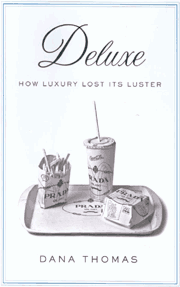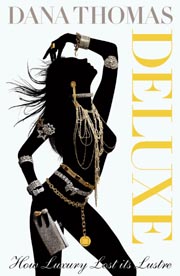|
living:
our people
 Dana Thomas, lady luxe Dana Thomas, lady luxe
Sylvia Giles interviews Dana
Thomas, author of Deluxe:
How Luxury Lost Its Luster, who uncovers some of the negative
sides of globalization and the fashion business
From issue 26
of Lucire
HAVING DEVOURED Dana Thomas’ book
Deluxe: How Luxury Lost Its Luster, I waited to interview
her at the bar in the Hilton. A fitting venue considering the content
of the book, which is a page-turner dissection of the industry of
luxury goods. In fact, a little too fitting, I realized, when I
was charged $5 for a flat white. But, if anything, it did underpin
the point that you don’t make lots of money without a high profile
and inflated prices. I found Dana tucked up in the corner, over
a cup of Earl Grey, almost oblivious to her setting. She had just
finished filming for Campbell Live, looking smart yet very
much at ease, and very down to earth.
Dana Thomas’s book makes New Zealand’s fashion
industry look like a well-mannered vegan. For anyone unfamiliar
with the amounts of money that pass through this industry, ‘luxury’
sales are at $157 billion dollars a year. The first thing Dana points
out when I check this fact with her (just to make sure I had read
it correctly) is that Bernard Arnault, CEO
of LVMH, announced that this figure
is expected to double, in five short years.
It is these conglomerates that form the epicentre
of her book, brands that were once owned by the families that started
them, and pieces were assembled by hand. For those who aren’t familiar
with the state of play, most fashion brands are now owned by umbrella
companies, the greatest of which is LVMH
Moët Hennessy Louis Vuitton. The accruing of these fashion
houses by tycoons such as Arnault have all the elements for good
drama; intrigue, deception, corporate takeovers, ex-lovers, and
of course, monstrous amounts of money at stake. The main protagonist
as she weaves her narrative throughout the book, in fact, tends
to be the staggering numbers.
It’s important to recognize that she has not written
about the fashion industry at as a whole, but the high-end market.
And customers of the ‘luxury industry’ have recently found themselves
in a monogrammed nirvana—interlinking LVs, double Cs
and Gs being the biggest culprits. The houses that were once
exclusive have systematically gone about mass-producing and mass
marketing their "dream", often in developing nations.
So why are the prices so inflated? And have we lost the elements
that justified those prices to begin with?
Over the last 15 years, a formulaic equation has
been developed to market luxury goods to the carnivorous consumer.
Handbags and perfumes act as gateway drugs to the hard stuff, the
“A-class drug” being ready-to-wear or even couture. In
the hands of Thomas all this makes for very interesting reading.
Over the course of almost 400 pp., Dana effectively deconstructs
the notions of haute couture surviving in this consumerist world.
The theme of art’s bickering with business resurfaces time and time
again, which has seen the book procure fans from outside fashion
devotees. ‘I had a luncheon in Los Angeles,’ she remembers, ‘and
a woman came up to me and said, “I loved your book, I loved
your book. But more importantly, my husband loved your book!”
[He was] an executive at General Motors. And he said, “It’s
not a book about fashion, it’s a book about commerce.” And
he ordered it for all his executives in Detroit and made them read
it.’
There is an entire chapter dedicated to the exposure
of the counterfeit handbag, debunking any notion of it being a “victimless
crime”. And such reporting is not done from the safety of a
desk, in conjuncture with the omnipotent Google, but in the field.
She dons a bulletproof vest as she follows a bust in the Chinese
district of Guangzhou.
It is with tales such as these that Thomas incorporates
a large amount of objection into her work. Was this a protest book
for the writer, after 15 years of living in Paris covering the fashion
industry? ‘Yeah, maybe. I’ve always been politically aware, and
I wanted to be a political reporter. Maybe I am a political reporter,
and I didn’t realize it.’
I asked Thomas what she found to be the most surprising
in researching the piece. She replied, ‘I knew a lot of companies
produced their goods overseas and in developing nations, but I didn’t
realize how many companies, and how much they produce overseas.
I was shocked. When I walked onto factory floors in China, and saw
brands where executives had had told me to their face that they
did not produce in China, being made there on the factory floor,
my mouth just fell open.’
Dana resides permanently in Paris with her husband,
and is almost globalization personified. The book, if anything,
emphasizes how much smaller our world is becoming with globalization,
how lines of class, geography and culture are increasingly out of
focus. And as globalization takes its hold, there doesn’t seem to
be much room for patriotism, the kind of patriotism that Americans
of course, are famous for. With a freshly launched Made in New
Zealand campaign gracing our own screen and bus stops, I had
to wonder if this has played a role in the fashion industry in the
current global climate—the prime example being President Bush asking
the American public to buy American-made straight after 9-11.
‘Oh my God,’ she says in her American drawl.
‘My husband turned to me and said, “Do you realize your president
just told the country to go shopping?” And actually when I
started working on the book, I had this idea: “Oh my God, how
to save the world from terrorism: go shopping!”’
However, there are aspects that deliver for those
who might prefer their handbag without a dose of politics. ‘One
of the first things I did was go to Florence, and visit the old
silk factory.’ She recounts, ‘The oldest working silk factory in
Europe. Spending a whole day to produce one inch of the most sumptuous
fabric.’
To be sure, this is a book you may live precariously
through. And I had every intention of living precariously through
my interview. I swooned quietly as she refers to ‘Karl’ and ‘Marc’
on a first-name basis, and her interview list reads as a Who’s
Who of the fashion industry. Her interview with Muiccia Prada
is a fascinating read, to which she comments, ‘It was like a really
intense chess game, where she was trying to outmanśuvre me. And
wasn’t really talking to me, but messing with me. We staggered out,
we both staggered and I was like, “I’m not sure who won—was
it was a draw?”’ But after a moment she adds, ‘Actually I won.
I won because in the end, she lied to me, and I knew she lied to
me. And she knew I knew. And she realized. I won. Check!’
Her most intimidating interview? ‘Karl. Karl Lagerfeld
is always intimidating. Mostly because he speaks so fast. So fast.
He is so smart. And it was just after the couture show. But he was
so lovely and accommodating.’
The thoroughness of her research is one of the
most satisfying aspects of the book and, thankfully, it is not only
uncovering doom and gloom, but providing uplifting passages for
those of us that still harbour romantic notions of the fashion industry.
Thomas maybe a cynic, but she is also a connoisseur. Shoe designer
Christian Louboutin, who Thomas refers to as a ‘luxury refugee’,
is quoted elegantly as saying, ‘If you do luxury, you have to treat
people in a human way and you have to be elegant. You can’t ask
poor people in bad conditions to make beautiful things.’
The tale of Coco Chanel’s No. 5 takes her to the
flower farms of Grasse, that Chanel insists on using despite many
other companies turning to alternatives in either developing nations
such as Egypt, or even a test tube for synthetic ingredients. ‘One
of the most magical moments was when I went down to the rose fields
in Grasse. Real farmers. Growing these roses for decades.’
I had to ask (although I made sure it was sandwiched
in nicely between intelligent questions surrounding the economy
and globalization), ‘How many handbags do you own?’ Well, the answer
is one, but it’s a terribly nice one, a Hermès Kelly bag,
that she has owned for no less than 15 years. Hermès is another
company she holds up as an example of enduring craft, and she proudly
shows me the stamp of the craftsman discreetly tucked away behind
the buckle.
‘And what scent do you wear?’ I pressed. She has
always worn Chanel No. 5, since she was 18. This woman not only
does thorough research, in the field, but she also practises what
she preaches.
The media, however, did go unscathed—whether this
has anything to do with a journalistic bias is unclear. Perhaps
it’s because it would constitute a book in itself, but I would have
expected at least a passing mention to its role. Additionally, the
most interesting questions surrounding the movement of the rich
to buy (excellent) fakes, and the middle class pinching pennies
for the real deal, went relatively unanswered. Certainly, this is
a luxury world in full upheaval—but while there was plenty of mention
as to how people are buying, sustaining, or even faking glamour
and luxury, the why was left begging for inclusion. There are many
cleverly selected anecdotes surrounding fashion victims and their
complete seizure on a logo of choice (the best of which being in
Japan) but why these brands become like a religion to many people
could perhaps be the topic of a sequel.
However, Deluxe was easily one of the most
thorough books I have read in a long time. I thought carefully about
my final question, what to ask the author who has seen it all? I
decided on: ‘If you could change one thing about the luxury industry,
what would it be?’
After some thought she replied, ‘Take it off the
stock market. The people who are making the decisions for the wrong
reasons—for short-term profit gains. My husband is a trader—so we
clash there,’ she says with a laugh. ‘It changes your raison
d’être, your focus, and what you want to achieve. I think
for luxury, definitely, it’s just killed it.’ •
Sylvia Giles is a senior writer for Lucire.
Add
to Del.icio.us | Digg
it | Add
to Facebook
|



Top: Dana Thomas. Centre and above: The US and New
Zealand covers for Thomas’s book, with Luster spelt
the British way in the New Zealand copies.
There is an entire chapter dedicated to the exposure
of the counterfeit handbag, debunking any notion of it being a “victimless
crime”. And such reporting is not done from the safety of a
desk, in conjuncture with the omnipotent Google, but in the field.
She dons a bulletproof vest as she follows a bust in the Chinese
district of Guangzhou
|

